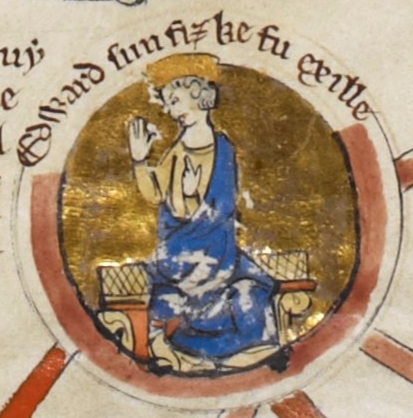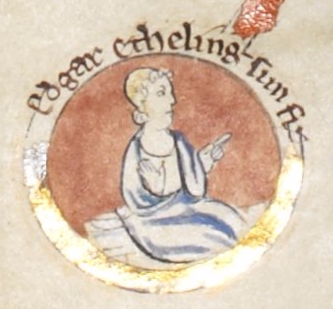by Susan Flantzer
© Unofficial Royalty 2019

Edmund II Ironside, King of the English; Credit – Wikipedia
Born around 990, Edmund was the third of the six sons of Æthelred II (the Unready), King of the English and his first wife Ælfgifu of York. Edmund was not expected to become king as he had two elder brothers but they both predeceased their father.
(Note: Ætheling was used in Anglo-Saxon England to designate princes of the royal dynasty eligible for the kingship.)
Edmund’s known full siblings were:
- Æthelstan Ætheling (died 1014)
- Ecgberht Ætheling (died c. 1005)
- Eadred Ætheling (died before 1013)
- Eadwig Ætheling (died 1017)
- Edgar Ætheling (died c. 1008)
- Eadgyth, married Eadric Streona
- Ælfgifu, married Uhtred the Bold, Ealdorman of Northumbria
- Wulfhilda, married Ulfcytel Snillingr
- Name unknown, Abbess of Wherwell Abbey
In 1002, Edmund’s mother Ælfgifu died, possibly in childbirth, and his father made a second marriage to Emma of Normandy, the daughter of Richard I, Duke of Normandy. Edmund had three half-siblings from this marriage:
- Edward the Confessor, King of the English (between 1003 and 1005 – January 5, 1066), married Edith of Wessex, no children
- Goda of England (1004 – circa 1047), married (1) Drogo of Mantes, Count of the Véxin, had children and (2) Eustace II, Count of Boulogne, no children
- Alfred Ætheling (circa 1005 – 1036), unmarried
When Sweyn Forkbeard, King of Denmark seized the English throne in 1013, Æthelred fled to Normandy but his two eldest surviving sons Æthelstan and Edmund remained in England. The two brothers had a close relationship and when Æthelstan died in 1014, he left Edmund his most prized possession, a sword that had once belonged to King Offa of Mercia.
The reign of Sweyn Forkbeard was short-lived as he suddenly died on February 3, 1014. Sweyn’s elder son succeeded him in Denmark as Harald II, King of Denmark, and his younger son Cnut (the Great), was proclaimed King of England by the Danes in England. However, leading English noblemen sent a deputation to Æthelred II to negotiate his restoration to the throne. Æthelred returned from exile in Normandy in the spring of 1014, managed to drive Cnut out of England, and then reigned until his death on April 23, 1016.

Medieval illumination depicting Kings Edmund Ironside (left) and Cnut (right), from the Chronica Majora written and illustrated by Matthew Paris; Credit – Wikipedia
Edmund was now King of the English but had to fight Cnut to keep the Kingdom of England. He earned the added name “Ironside” because of his bravery in resisting the Danish invasion led by Cnut the Great. The war between Edmund and Cnut ended in a decisive victory for Cnut at the Battle of Assandun on October 18, 1016. Because Edmund’s reputation as a warrior was great, Cnut agreed to divide England, with Edmund taking Wessex and Cnut the rest of the country beyond the River Thames. However, Edmund died on November 30, 1016, and Cnut the Great became King of England. Edmund was buried near his grandfather Edgar the Peaceful, King of the English at Glastonbury Abbey in Somerset which was destroyed during the Dissolution of the Monasteries during the reign of King Henry VIII.

Ruins of Glastonbury Abbey; Credit – By Pam Brophy, https://commons.wikimedia.org/w/index.php?curid=9115142
Cnut later became King of Denmark and King of Norway and married Æthelred’s widow Emma of Normandy. Cnut and his sons Harold Harefoot and Harthacnut ruled England from 1016 – 1042. After Harthacnut’s death, the English throne reverted to the House of Wessex under Æthelred II’s younger son by Emma of Normandy Edward the Confessor.

Edward the Exile. Edmund Ironside’s elder son; Credit – Wikipedia
Edmund’s two sons via his marriage with Ealdgyth have an interesting history.
- Edward the Exile (1016 – 1057), married Agatha, had three children
- Edmund Ætheling (circa 1017 – circa 1054), married Hedwig of Hungary, no children
According to the English monk and chronicler John of Worcester, after Edmund’s death, King Cnut sent his two very young children to King Olof Skötkonung of Sweden to be murdered but instead, King Olof sent them to Kyiv where his daughter was the queen. Sometime in the 1040s, Edward and Edmund, now adults, both traveled to Hungary and helped the exiled Andrew of Hungary become King of Hungary. Edmund died in Hungary before 1054. Edward the Exile married Agatha, whose background is uncertain. Edward and Agatha had three children who were all born in Hungary:
- Saint Margaret of Scotland (circa 1045 – 1093), married Malcolm III, King of Scots, had eight children including three Kings of Scots (Edgar, Alexander I, and David I) and Edith, also called Maud or Matilda, who married King Henry I of England
- Edgar the Ætheling (circa 1051 – circa 1126), unmarried
- Cristina (circa 1057 – circa 1093), Abbess at Romsey Abbey

Edgar the Ætheling, grandson of Edmund Ironside; Credit – Wikipedia
In 1057, Edward the Confessor, the childless King of England, discovered that his nephew Edward the Exile was still alive and summoned him to England in 1057 as a potential successor. However, Edward died within two days of his arrival in England and the cause of his death has never been determined. Murder is a possibility, as he had many powerful enemies. After his father’s death, his son Edgar the Ætheling had the best hereditary claim to the English throne. Edmund Ironside’s three children were then raised in the court of Edward the Confessor, who died in January 1066. Edgar was considered too young to be king and the Witenagemot elected Harold Godwinson king mainly because it was thought he could defend England against foreign claimants to the English throne.
In October 1066, William of Normandy (the Conqueror) invaded England and defeated King Harold at the Battle of Hastings. Following Harold’s death in battle, the Witenagemot elected Edmund’s son Edgar the Ætheling, the last of the House of Wessex, King of England. As William of Normandy’s position grew stronger, it became evident to those in power that King Edgar should be abandoned and that they should submit to William.

Edmund Ironside’s granddaughter Saint Margaret of Scotland, stained glass window at St. Margaret’s Chapel at Edinburgh Castle; Credit – Wikipedia
In 1068, Edgar, his mother Agatha, and sisters Margaret and Cristina fled to Northumbria. Agatha wanted to return to Hungary but their ship was blown off course by a storm. They sought refuge from Malcolm III, King of Scots, who is the Malcolm in the play Macbeth by William Shakespeare. Malcolm’s first wife Ingebjorg Finnsdotter died around 1069, and shortly thereafter he married Margaret who was canonized a saint in 1250. Margaret and Malcolm had eight children, six sons and two daughters. Bearing in mind that William the Conqueror’s new dynasty in England was not secure and their sons would have a claim on the English throne, Margaret and Malcolm gave four of their sons Anglo-Saxon royal names and named the other two sons after Alexander the Great and the biblical King David. Their elder daughter Edith (also known as Matilda) married King Henry I of England and brought the bloodline of the Anglo-Saxon kings into the English/British royal family. Their other daughter Mary was the mother of Matilda of Boulogne who married King Stephen of England.
This article is the intellectual property of Unofficial Royalty and is NOT TO BE COPIED, EDITED, OR POSTED IN ANY FORM ON ANOTHER WEBSITE under any circumstances. It is permissible to use a link that directs to Unofficial Royalty.
England: House of Wessex Resources at Unofficial Royalty
- Unofficial Royalty: House of Wessex Index
- Unofficial Royalty: British Royal Burial Sites: House of Wessex
- Unofficial Royalty: Coronations before the Norman Conquest (871 – 1066)
Works Cited
- Ashley, M. (1998). The Mammoth Book of British Kings & Queens. New York: Carroll & Graf Pub.
- Cannon, J. and Griffiths, R. (1988). The Oxford Illustrated History of the British Monarchy. Oxford: Oxford University Press.
- Dodson, A. (2004). The Royal Tombs of Great Britain. London: Duckworth.
- En.wikipedia.org. (2019). Edmund Ironside. [online] Available at: https://en.wikipedia.org/wiki/Edmund_Ironside [Accessed 28 Feb. 2019].
- Flantzer, S. (2015). Æthelred II (the Unready), King of the English. [online] Unofficial Royalty. Available at: https://www.unofficialroyalty.com/aethelred-ii-the-unready-king-of-the-english/ [Accessed 25 Feb. 2019].
- Flantzer, S. (2013). Saint Margaret of Scotland, Queen of Scotland. [online] Unofficial Royalty. Available at: https://www.unofficialroyalty.com/november-16-1093-death-of-saint-margaret-of-scotland-wife-of-king-malcolm-iii-of-scotland/ [Accessed 28 Feb. 2019].
- Williamson, D. (1998). Brewer’s British Royalty. London: Cassell.
